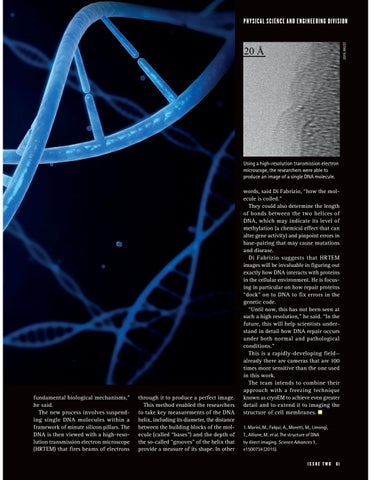2015 KAUST
P H YS ICAL S C IE N C E A ND E N G IN EERIN G DIVI SI ON
Using a high-resolution transmission electron microscope, the researchers were able to produce an image of a single DNA molecule.
fundamental biological mechanisms,” he said. The new process involves suspending single DNA molecules within a framework of minute silicon pillars. The DNA is then viewed with a high-resolution transmission electron microscope (HRTEM) that fires beams of electrons
through it to produce a perfect image. This method enabled the researchers to take key measurements of the DNA helix, including its diameter, the distance between the building blocks of the molecule (called “bases”) and the depth of the so-called “grooves” of the helix that provide a measure of its shape. In other
words, said Di Fabrizio, “how the molecule is coiled.” They could also determine the length of bonds between the two helices of DNA, which may indicate its level of methylation (a chemical effect that can alter gene activity) and pinpoint errors in base-pairing that may cause mutations and disease. Di Fabrizio suggests that HRTEM images will be invaluable in figuring out exactly how DNA interacts with proteins in the cellular environment. He is focusing in particular on how repair proteins “dock” on to DNA to fix errors in the genetic code. “Until now, this has not been seen at such a high resolution,” he said. “In the future, this will help scientists understand in detail how DNA repair occurs under both normal and pathological conditions.” This is a rapidly-developing field— already there are cameras that are 100 times more sensitive than the one used in this work. The team intends to combine their approach with a freezing technique known as cryoEM to achieve even greater detail and to extend it to imaging the structure of cell membranes. 1. Marini, M., Falqui, A., Moretti, M., Limongi, T., Allione, M. et al. The structure of DNA by direct imaging. Science Advances 1, e1500734 (2015).
ISSUE TWO
61
